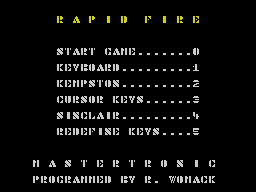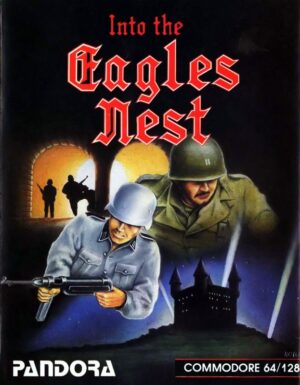Retro Replay Review
Gameplay
Rapid Fire throws players into the boots of an undercover cop on a high-stakes mission to dismantle a bank robber’s warehouse empire. The core action revolves around fast-paced run-and-gun sequences, where you blast through successive levels teeming with armed thugs. From the opening moments, you’ll notice your machine gun packs a punch—but continuous fire leads to overheating. This mechanic forces you to strike a balance between aggressive volleys and tactical pauses, adding a welcome layer of resource management to the standard side-scroll shooting formula.
(HEY YOU!! We hope you enjoy! We try not to run ads. So basically, this is a very expensive hobby running this site. Please consider joining us for updates, forums, and more. Network w/ us to make some cash or friends while retro gaming, and you can win some free retro games for posting. Okay, carry on 👍)
Each stage in Rapid Fire introduces new environmental hazards and enemy formations. Early levels focus on warehouse corridors littered with crates and barrels, while later stages transition into ventilation shafts, electrical chambers and storage docks. At the end of a handful of these stages, you’ll face a rotating plasma computer vent. Destroying that vent under a hail of energy bolts becomes an intense, almost puzzle-like encounter—timing your shots between incoming blasts is crucial, and it keeps the gameplay from feeling repetitive.
Weapon upgrades and ammo pickups are scattered throughout each level, incentivizing exploration even when under heavy fire. While the gun overheat mechanic resets your aim by forcing cooldown periods, it also encourages experimentation with movement and cover. You’ll dart behind crates, leap over gaps, and weave between enemy fire. The result is a tight, challenging experience that rewards both quick reflexes and strategic planning, ensuring each playthrough feels dynamic and demanding.
Graphics
Visually, Rapid Fire nails the gritty atmosphere of an underground criminal operation. The warehouse interiors are richly detailed with flickering lights, rusted metal girders, and shadowy corners that keep you on edge. Textured walls and crates bear the scars of previous gunfights, creating a lived-in environment that feels authentic. The game’s color palette leans into steely grays and industrial blues, punctuated by the warm glow of sparking cables and plasma vents.
Character sprites are sharply designed, with the undercover cop sporting a rugged silhouette and jerky muzzle-flash animations when firing his machine gun. Enemy thugs come in varied outfits and carry different weapons, making it easy to spot tougher opponents at a glance. Particle effects shine during explosions and ricochets, adding a visceral punch every time a barrel detonates or plasma bolts splinter against metal surfaces.
One standout visual element is the rotating plasma vent encounter. The vent’s translucent blue glow casts dynamic lighting across the chamber, and the fast-flying energy bolts leave luminous trails that heighten the sense of urgency. Though the game doesn’t push ultra-realistic graphics, its stylized, arcade-inspired aesthetic is polished and consistent. Frame rates remain stable even in the most frantic firefights, ensuring that the graphics support—rather than hinder—the high-intensity action.
Story
Rapid Fire’s narrative is straightforward but effective: you are an undercover cop infiltrating a warehouse network run by a gang of bank robbers. The central goal is to reach the master level, where the rogue group’s main power electrode lies, and destroy it once and for all. While the storyline doesn’t bend your mind with twists, it provides just enough motivation for you to care about every corridor you clear and every boss you topple.
Story beats are delivered through brief text interludes between levels and atmospheric in-game hints, like tagged walls and intercepted radio chatter. These moments set the stage for your next objective—whether it’s locating keycards, sabotaging control panels, or simply fending off waves of reinforcements. Though there are no fully voiced cutscenes, the game makes up for it with tight pacing: there’s never a dull moment where you’re left wondering why you’re storming the next room.
By the time you confront the final central electrode chamber, the stakes feel appropriately high. You’ve already dismantled multiple plasma computers, navigated hazardous traps, and outgunned countless foes. The culminating showdown ties back to earlier levels, echoing familiar threats while escalating both firepower and tension. It’s a lean narrative, but it maintains momentum from start to finish, ensuring that your undercover cop’s mission feels coherent and driven.
Overall Experience
Rapid Fire delivers a satisfying blend of reflex-driven shooting and tactical weapon management. The heat-build mechanic on your machine gun keeps you mindful of ammo conservation, while environmental obstacles and plasma vent bosses provide enough variety to prevent monotony. This combination makes for a tight gameplay loop that’s easy to learn but challenging to master.
The game’s polished graphics and industrial sound design immerse you in a world of flickering lights and crackling power conduits. Every explosion and bullet impact feels weighty, enhancing the visceral thrill of combat. Although the story is lean, it moves at a brisk pace, ensuring you’re always aware of your ultimate goal without being bogged down by lengthy exposition.
For fans of classic run-and-gun shooters, Rapid Fire offers a compelling package. Its difficulty curve is fair yet punishing at higher levels, providing a genuine sense of accomplishment when you clear that final plasma vent or sabotage the master electrode. Whether you’re a completionist hunting down every upgrade or a speedrunner aiming for the fastest playthrough, Rapid Fire will keep you on your toes from the first shot to the last.
 Retro Replay Retro Replay gaming reviews, news, emulation, geek stuff and more!
Retro Replay Retro Replay gaming reviews, news, emulation, geek stuff and more!









Reviews
There are no reviews yet.